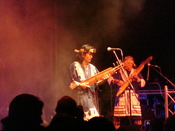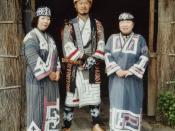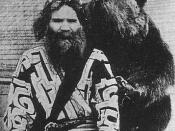David Harvey
Almond
Honors World Civilizations
Period: 2
Discrimination of the Ainu in Japan
The Ainu (meaning "human" or "us") are an indigenous minority group who live in Japan and parts of Eastern Russia. According to Ainu legend, the Ainu came to Japan over 100,000 years before the current "Yamato" Japanese people arrived. Despite the fact that the Ainu have a longer history than the ethnic Japanese people themselves, they are still discriminated against to this day.�
Origin of the Ainu
There have always been many different theories about the Ainu's origin. Some of these theories stated that the Ainu came from Oceania or isolated islands from other regions; from Europe and that they were of Caucasian descent; and from Asia's mainland but are from older inhabitants than the current races.�
These theories were mostly based on the physical appearance of the Ainu because genetic testing was not available. More recent studies, using genetic testing, show that the Ainu have some genetic similarities with people from Tibet and the Andaman Islands located in the Indian Ocean.�
No one knows when the Ainu first arrived in Japan, although legend says they arrived over 100,000 years before the ethnic Japanese.
The Ainu
The Ainu are very different from the ethnic Japanese people of Japan. They are much taller and of a fairly larger build. They are a lot more hairy and never cut their beards. When the women marry, they tattoo what seems to be facial hair around their lips to mimic the men's thick beards. Many people believe that the Ainu descended from the Caucasian race, because of their fair colored skin and round eyes.�
The Ainu are a religious people and still practice many of their ancient traditions, although many have been lost. They believe in many different gods and that every entity whether living or nonliving has an incarnation of a god in them. Not all of the gods that they have a belief in are good. Some are evil. For example, any sort of disease is considered a bad god.
The most important incarnation of a god is the bear. The ceremony called "Iyomante" in which the spirit of a bear is sent back to the divine world is done once a year. In any ceremony, the Ainu will give gifts to the object or animal that is being sent back to the divine world. The gifts are the Ainu's way of inviting the object or animal to return to the human world.�
In the "Iyomante" ceremony the Ainu will appoint a human mother for a bear cub, which they will steal from a hibernating den at the end of winter. This mother will care for the cub until it is grown and ready to be sacrificed and sent back to the divine world. When it is autumn, the bear will be given many gifts and treated as an honored guest given beer, sake and a grand feast. The ceremony will last for three days. At the end of three days arrows are shot into the bear killing it and finally sending it back to the divine world after it's time in captivity. The Ainu then drink the blood of the bear to achieve its magnificent powers. The bear's blood will also be sprinkled over the sick to cure them.�
Anything can be sent back to the divine world through some sort of ceremony. "Iwakte" is the ceremony that sends back the spirit of a small item that is no longer used. "Iwakte" is also used for any small animal that needs to be sent back to the gods.�
The Ainu have their own separate language from the rest of Japan, which was passed down orally from generation to generation. It is believed that their language could have originated from the Aleut and Eskimos since many of their words resemble each other and the pronunciations are very similar. There are many theories about where the Ainu could have originated, since there are so many similarities with other ethnicities and cultures.�
The Arrival of Ethnic Japanese
It is unclear when the ethnic "Yamato" Japanese arrived in Japan, but it is indubitable that they were not there before the Ainu people. Around 10,000 B.C. to 300 B.C. the Japanese mostly lived by hunting and gathering. This era was called the Jomon period, which is mostly marked by the pottery that is found all over Japan.�
From 300 B.C. to 710 A.D. the Japanese began to propagate rice and other agricultural vegetation. They also started an imperial family that they considered to be direct descendants from the sun goddess, Amaterasu. This belief was the beginning of the Japanese belief of the divine nature of their emperors.�
While the emperor was in his position, many samurai who owned land fought amongst themselves for more land, thus making the emperor powerless. This divided Japan into prefectures ruled by Daimyo who ruled over those that lived on their estates.�
In 1185 A.D., Minamoto Yoritomo gained absolute leadership over all of the prefectures of Japan. He was now the leader over the Emperor himself. Seven years later Minamoto Yoritomo gained the first Shogunate and was named the shogun over all of Japan.�
There were three different Shogunates. Each one lost power and was reestablished by another family, except for the last one. The last Shogunate ended when Emperor Meiji opened up Japan to the outside world and began to modernize his country. At this time, Japan used guns and other modern weapons against the samurai, abolishing them forever.�
After the eradication of the Samurai, Japan became more modern, adopting a constitution and other western ideas.�
Japanese Relationship with the Ainu
The Japanese and Ainu did not affiliate until around 1400 A.D. when they had their first meetings and began to cordially trade with one another. Although their relationship started off peacefully, the Japanese soon sought to seize Hokkaido from the Ainu. This notion soon led to the battle of Kosyamain in 1457, the battle of Syaksyain in 1669 and the final battle of Kenasiri-Menasi in 1789. The Ainu lost all three battles. After the last battle the Ainu were ruled by Japan. The Ainu Population began to drop very quickly because of diseases and forced labor from the Japanese.�
In 1868 the Ainu were not allowed to practice their ancient customs. In 1899 the Japanese government imposed the Hokkaido Former Aborigines Protection Act to try to make the Ainu live and act "Japanese." Despite the fact that the Ainu were now living the ways of the Japanese people they were still not treated the same. The Ainu were called "Kyu-dojin" meaning "former aborigines". This act was not repealed until 1997 when the Ainu people were finally recognized as an indigenous group of Japan.� In 1946, The Hokkaido Ainu Association was established in order to keep Ainu traditions alive and to help the Ainu's social status in Japanese society. It is still active today, though it has since changed its name to Hokkaido Utari Association.� Although Ainu culture was once pronounced dead the past few decades have seen people of Ainu descent assert their ethnicity both politically and culturally.�
The Ainu People in Modern Society
Many Ainu today live in cities just like any other Japanese citizen living normal lives. Although they live with the Japanese people they still are not immune to discrimination. Many Ainu will hide their identity to avoid social prejudice. Some of the Ainu that live among the Japanese are not even aware of their ancestry because their parents, grandparents or other ancestors, kept it a secret to protect their family.�
While countless Ainu are unaware of his or her origin, a survey coordinated by the Hokkaido Government in 2006 taken in 72 cities showed that there were 23,782 Ainu living in Hokkaido at that time.� The survey cannot be completely accurate considering that they couldn't find all of the Ainu people. Ainu activists estimate that there are around 50,000 to 100,000 Ainu surviving today in Hokkaido and other parts of Japan.� Other estimations show that there could be around 200,000 people of Ainu descent currently living in Japan.� However, it is also estimated that less than 200 people in Japan that can claim that both of their parents are from exclusively Ainu descent.�
Because of the Ainu's "former aboriginal" status, intermarriage is looked down upon in Japanese society. However, as the Ainu become more integrated into Japanese society, intermarriage is becoming more common.�
Although the Ainu gained back the right to conduct their traditions in 1997, most of the Ainu live very modern lives. There are still some who keep their customs alive, but this number is very small.�
Life for the Ainu is sometimes hard. Discrimination gives them a lot of challenges including not being accepted for jobs.� In 2006 38.3% of Ainu were using welfare in Hokkaido.�
The percent of Ainu people who attended high school in 1972 was 41.6%. That percentage grew to 95.2% in 1999. The percent of Ainu people who went to a university in 1972 was 0%. That percentage grew to 8.8% in1979 in which it then grew to 16.1% in 1999.� It eventually grew to 17.4% in 2006.�
Conclusion
The Ainu live in poverty because of discrimination by the Japanese people, however, they are starting to see a change. New laws are being passed to help the Ainu live in peace with the rest of Japan and still keep their ancient customs. They will not stop working to get equal rights for all the Ainu people of Japan. Although the Ainu are still discriminated against by the Japanese, they are beginning to thrive as the Japanese people begin to accept them as their own.
BIBLIOGRAPHY
Andy Sharp, Tokyo's Thriving Ainu Community Keeps Traditional Culture Alive,
http://www.japantoday.com/category/lifestyle/view/tokyo%E2%80%99s-thriving-ainu-community-keeps-traditional-culture-alive (2009).
Catherine Makino, Indigenous People: Japan Officially Recognizes Ainu,
http://ipsnews.net/news.asp?idnews=42738 (2008).
Edo Nyland, The Relationship Between the Basque and Ainu,
https://www.islandnet.com/~nyland/ainu.htm
Encyclopedia Britannica Online, Shogunate,
http://www.britannica.com/EBchecked/topic/541431/shogunate (March 2009).
Kara Knafelc, Japan: The Culture (Lonely Planet Publications Pty Ltd., 2005), p. 44.
KidsKnowIt Network, Japanese Feudalism,
http://www.kidspast.com/world-history/0259-japanese-feudalism.php (2009).
Masami Ito, "Ainu: Indigenous In Every Way But Not By Official Fiat." The Japan Times, (May 20, 2008).
Michiko Nagao, Rediscovering the Treasures of Food, Vol 6: Salmon Sacchep,
http://www.tokyofoundation.org/en/series/japanese-traditional-foods/vol.-6-salmon-sacchep/?searchterm=ainu (September 22, 2008).
National Diet Library, Birth of the Constitution of Japan, Part 5: Enactment of the Constitution of Japan,
http://www.ndl.go.jp/constitution/e/outline/05outline.html (2004).
Ostara Publications, March of the Titans, A History of the White Race, Appendix 14: The Mystery of the Ainu of Japan,
http://www.white-history.com/ainu_in_japan.htm (October 2008).
Ryotaro Shiba, The Last Shogun - The Life of Tokugawa Yoshinobu, (Bungeishunju Co., Ltd., 1967).
Steve Lussing, Japan's Ethnic Ainu People,
http://www.helium.com/items/1007606-japans-ethnic-ainu-people (2009).
Takehiko Kambayashi, "Japan's Ainu Hope New Identity Leads to More Rights." The Christian Science Monitor, (June 9, 2008).
The Ainu Association of Hokkaido, What is the Ainu Association of Hokkaido,
http://www.ainu-assn.or.jp/english/eabout04.html (March 2008).
The Ainu Museum Foundation, The Ainu People,
http://www.ainu-museum.or.jp/english/english.html (July 2000).
The Field Museum, Commentary by Stev Weidlich, The Boone Collection-Image Gallery: Ainu Artifacts,
http://www.fieldmuseum.org/research_collections/anthropology/anthro_sites/boone/ainu/ainu_comlinks/ainu_comlink3.html (2009).
Thomas C. Smith, The Agrarian Origins of Modern Japan (Stanford University Press, 1959), p. 32.
Web Japan, History of Japan,
http://web-japan.org/museum/historyofjp/histjp.html
� The Ainu Museum Foundation, The Ainu People,
http://www.ainu-museum.or.jp/english/english.html (July 2000).
� The Ainu Museum Foundation, The Ainu People,
http://www.ainu-museum.or.jp/english/english.html (July 2000).
� Steve Lussing, Japan's Ethnic Ainu People,
http://www.helium.com/items/1007606-japans-ethnic-ainu-people (2009).
� Ostara Publications, March of the Titans, A History of the White Race, Appendix 14: The Mystery of the Ainu of Japan,
http://www.white-history.com/ainu_in_japan.htm (October 2008).
� The Ainu Museum Foundation, The Ainu People,
http://www.ainu-museum.or.jp/english/english.html (July 2000).
� The Field Museum, Commentary by Stev Weidlich, The Boone Collection-Image Gallery: Ainu Artifacts,
http://www.fieldmuseum.org/research_collections/anthropology/anthro_sites/boone/ainu/ainu_comlinks/ainu_comlink3.html (2009).
� The Ainu Museum Foundation, The Ainu People,
http://www.ainu-museum.or.jp/english/english.html (July 2000).
� Edo Nyland, The Relationship Between the Basque and Ainu,
https://www.islandnet.com/~nyland/ainu.htm
� Web Japan, History of Japan,
http://web-japan.org/museum/historyofjp/histjp.html
� Thomas C. Smith, The Agrarian Origins of Modern Japan (Stanford University Press, 1959), p. 32.
� KidsKnowIt Network, Japanese Feudalism,
http://www.kidspast.com/world-history/0259-japanese-feudalism.php (2009).
� Encyclopedia Britannica Online, Shogunate,
http://www.britannica.com/EBchecked/topic/541431/shogunate (March 2009).
� Ryotaro Shiba, The Last Shogun - The Life of Tokugawa Yoshinobu, (Bungeishunju Co., Ltd., 1967).
� National Diet Library, Birth of the Constitution of Japan, Part 5: Enactment of the Constitution of Japan,
http://www.ndl.go.jp/constitution/e/outline/05outline.html (2004).
� Steve Lussing, Japan's Ethnic Ainu People,
http://www.helium.com/items/1007606-japans-ethnic-ainu-people (2009).
� Takehiko Kambayashi, "Japan's Ainu Hope New Identity Leads to More Rights." The Christian Science Monitor, (June 9, 2008).
� The Ainu Association of Hokkaido, What is the Ainu Association of Hokkaido,
http://www.ainu-assn.or.jp/english/eabout04.html (March 2008).
� Kara Knafelc, Japan: The Culture (Lonely Planet Publications Pty Ltd., 2005), p. 44.
� Masami Ito, "Ainu: Indigenous In Every Way But Not By Official Fiat." The Japan Times, (May 20, 2008).
� The Ainu Association of Hokkaido, What is the Ainu Association of Hokkaido,
http://www.ainu-assn.or.jp/english/eabout04.html (March 2008).
� Masami Ito, "Ainu: Indigenous In Every Way But Not By Official Fiat." The Japan Times, (May 20, 2008).
� Catherine Makino, Indigenous People: Japan Officially Recognizes Ainu,
http://ipsnews.net/news.asp?idnews=42738 (2008).
� Kara Knafelc, Japan: The Culture (Lonely Planet Publications Pty Ltd., 2005), p. 44.
� Andy Sharp, Tokyo's Thriving Ainu Community Keeps Traditional Culture Alive,
http://www.japantoday.com/category/lifestyle/view/tokyo%E2%80%99s-thriving-ainu-community-keeps-traditional-culture-alive (2009).
� Michiko Nagao, Rediscovering the Treasures of Food, Vol 6: Salmon Sacchep,
http://www.tokyofoundation.org/en/series/japanese-traditional-foods/vol.-6-salmon-sacchep/?searchterm=ainu (September 22, 2008).
� Andy Sharp, Tokyo's Thriving Ainu Community Keeps Traditional Culture Alive,
http://www.japantoday.com/category/lifestyle/view/tokyo%E2%80%99s-thriving-ainu-community-keeps-traditional-culture-alive (2009).
� Takehiko Kambayashi, "Japan's Ainu Hope New Identity Leads to More Rights." The Christian Science Monitor, (June 9, 2008).
� The Ainu Association of Hokkaido, What is the Ainu Association of Hokkaido,
http://www.ainu-assn.or.jp/english/eabout04.html (March 2008).
� Takehiko Kambayashi, "Japan's Ainu Hope New Identity Leads to More Rights." The Christian Science Monitor, (June 9, 2008).
�PAGE � �PAGE �1�





